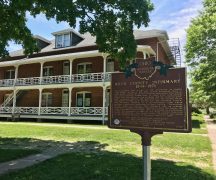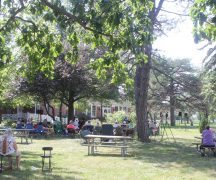By JAN LARSON McLAUGHLIN
BG Independent News
With a black and white Frank Sinatra crooning on the screen about the bliss of “Love and Marriage,” Alyssa Garland broke the news that all in the room undoubtedly already knew.
“Unfortunately, love and marriage didn’t always go together like a horse and carriage,” Garland said during a Wood County Museum tea program on the “evolution of spousal roles in American life.”
Garland, a Wood County Park District historic farm interpretive assistant and notably younger than her audience gathered for the monthly tea, pointed out that her credentials for the talk included three years of marriage.
She took her audience through centuries of spousal selections, expectations, and stresses. “Love” was not always among the criteria when picking out a spouse. It used to be all about survival.
Prior to the 1700s, marriage was all about building alliances between families, Garland said. During the barter society period, families survived on their shared skills. Child care and housework were spread among members.
There were expectations, she said. In some Native American cultures, marriages could be ended when roles weren’t fulfilled.
“Women would set their spouses’ belongings outside – and that was that,” she said.
Between 1700 and 1900, roles changed with the enlightenment and industrial revolutions, and with the beginning of a cash economy.
In many cases men worked for an employer – often in dangerous factory conditions, putting in long hours – and brought home an income. Women, however, primarily remained at home, taking on the work that used to be shared with their spouses. They did not have the luxury of finding a purpose in life outside their home, Garland said. And their status slipped in the marriage since they had no income of their own.
Then in 1910s and 1920s, the “lost generation” saw some shifts. Women gained the right to vote, some had time to find their own “fulfillment” in life, and the economy became consumer focused.
“Times are changing,” Garland said.
It was the beginning of the courting culture – when people started selecting spouses based on attraction.
But not everything changed. Men still provided the property and the house. “And the woman needs to make it a home,” she said.
During the “greatest generation” period of the 1930s and 1940s, people put off marriage due to economic hardships of the era. Though later, the marriages tended to last longer. More women began working outside the home during the Depression, and when men went off to fight in World War II, many women took on factory jobs.
Most of the women who attended college during this period went there to achieve an “MRS. degree,” Garland said.
Then came the “silent generation” in the 1950s and 1960s. The GI Bill allowed men, who had never before considered higher education, to attend college. Homeownership exploded – though racist policies stood in the way of many Black Americans, Garland noted.
“People are now expected to move out on their own,” rather than stay in the same home as family members. “People are encouraged to spend, spend, spend,” she said.
The average age of marriage dropped back down to 20-22. Children had “real childhoods,” that weren’t possible for most families before.
The traditional family had a cute little house, loaded with gadgets, a white picket fence, with children and a dog playing in the yard. The wife was making cookies when her husband came home from work, Garland said.
When the “baby boomer” generation entered marriage in the 1970s and 1980s, different shifts occurred.
“Obey” was removed from many wedding vows, birth control was more widely accessible, and women could open bank accounts and get credit cards without their husband’s approval.
The “Feminine Mystique” book was a bestseller, and women began wondering why they weren’t happy even though they had a beautiful house and children.
The rate of divorce “skyrocketed,” Garland said.
“Many women were finally finding the fulfillment of living alone,” she said.
Women turned to college for professions – not for husbands – and a houseful of children was no longer the goal for many.
“This was the baby burst after the baby boom,” she said.
When the Generation Xers came along in the 1990s and 2000s, the middle class was declining and more two-income households became a necessity. There was a rise in the birth rate, and a renewed focus on “traditional families.”
More women became the primary breadwinners, but they still did most of the work at home, Garland said.
In the 2010s and 2020s, millennials saw the legalization of gay marriage. Women outnumbered men in college. And the standard of living was lower than that of their parents.
Many put off marriage, kids and homeownership. More women postponed having children until their 30s. A quarter of millennials don’t get married until 40 or older, Garland said.
The “Supermom” phenomenon begins, and women feel the stresses of social media. Garland compared that pressure to the one-time trend of covering living room furniture with plastic – to make it appear nice to outsiders.
Today, more people are marrying for love, divorce rates are declining, and husbands are more likely to share duties at home, she said.
Garland predicted that when future generations look back at this era, they will study the effects of COVID on marriages and individual behaviors. Just as people who grew up during the Depression share some common traits of saving items and spending less, this era may also create some common behaviors.
“Time will tell,” she said. “Children may say, ‘Why does Grandma do that?’ And the answer will be, ‘Oh, she lived through COVID.’”





